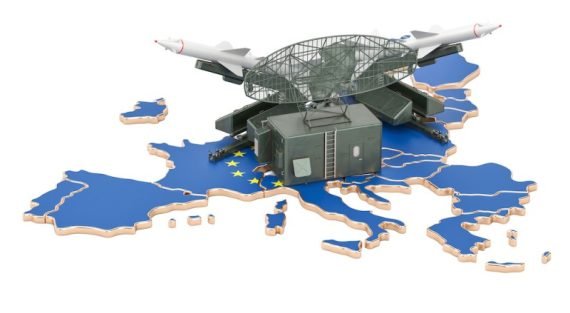The European Sky Shield Initiative (ESSI) is the latest step taken against the spiral of mistrust that emerged with the Russia-Ukraine war. The project was launched under the leadership of Germany, whose defense weaknesses have been on the agenda since the start of war in February 2022, drawing attention to its poor combat readiness and lack of basic military equipment.
Despite frequent warnings since the beginning of the war to increase ammunition production in European countries and to invest more in air and missile defense, European defense industry production has fallen further behind Russia. Meanwhile, as Russia shifted to a form of war economy, it significantly increased its production rate, further exacerbating insecurity in Europe.
Moreover, increased drone and missile strikes behind the front lines, intense attacks on critical infrastructure, and Russian missiles falling within NATO’s borders have put the need for air and missile defense in Europe back on the agenda. The ESSI is therefore expected not only to reduce vulnerability in this area, but also to encourage an overall increase in military spending on the continent and the development of a common understanding of defense.
The project aims to establish a layered air and missile defense network through the joint procurement and operation of the German Iris-T, American Patriot and Israeli Arrow-3 defense systems, thereby creating a cost-effective and interoperable network.
Why ISSI Is Needed for European Security?
Two fundamental challenges have played a driving role in the emergence of ESSI. The first is the fact that the development of missile and unmanned systems technology, as seen in recent conflicts and the war in Ukraine, could extend warfare behind the front lines.
The increasing use of large numbers of unmanned aerial vehicles (UAVs), which can be quickly and inexpensively produced and act as “missiles” with a saturation effect on air defense systems (neutralizing technologically superior enemy systems through numerical superiority), has reemphasized the importance of a multi-layered air and missile defense architecture.
Moreover, Russia’s intensive use of artillery, missiles, and drones to target Ukraine’s critical infrastructure, and thus its ability to easily take the war behind the front lines, has become a factor fueling insecurity in Europe. Events such as Russian missile and drone strikes landing on NATO borders, even in the absence of a direct attack, have exacerbated concerns and pushed Eastern European and Balkan countries to further bolster their military capabilities.
The second issue is Europe’s inability to increase its military spending and the expectation that ESSI could be a driving force. The negative effects of rapidly declining defense budgets and extensive force downsizing in the post-Cold War era are far from being reversed. Assessments show that most armies in Europe are grossly inadequate in terms of both combat readiness and equipment.
On a continent facing a serious challenge to increase its military spending, ESSI has the potential to foster cooperation by establishing a common procurement and operational mechanism for air and missile defense. Adopting a common procurement and operational mechanism offers several advantages, including interoperability and cost effectiveness through the division of labor for maintenance and operations.
Possibly in the later stages of the project, joint development projects have the potential to create a cost-effective and sustainable European defense industrial ecosystem. European defense companies have come up with various project ideas, such as the need to develop projects like Israel’s Iron Dome system in Europe. ESSI represents a positive development in terms of enhanced defense cooperation, more effective information sharing, a cost-effective procurement system and increased interoperability.
Can ESSI Succeed?
The project is unlikely to succeed for a number of reasons. So far, the continent has failed to adopt a common position on security, defense and foreign policy. Although the project has been on the agenda for about a year and a half, no serious progress has been made except for the recruitment of new members due to the high cost of the systems to be procured. In addition, Germany and France have different approaches to war and common defense. All this inevitably puts the future of ESSI in a stalemate.
In the aftermath of the Ukraine war, France has become more emphatic about European strategic autonomy and the development of the European defense industrial ecosystem. However, it is noteworthy that the delays in the new generation aircraft and tank projects with Germany cannot be overcome.
French President Emmanuel Macron’s contradictory statements since the beginning of the war and his inability to find common ground with German Chancellor Scholz make it even more difficult to develop common policies, a situation that was recently repeated during the debate on the possible deployment of troops in Ukraine.
France’s refusal to participate in the ESSI, and even its frequent open criticism of the initiative, is one of the incompatibilities demonstrated by these differences. France considers the ESSI to be a project that will damage the Union’s defense industrial ecosystem, as it provides for the procurement of weapons systems from outside the EU.
It is worth recalling that France, along with Greece and Southern Cyprus, vetoed the delivery of urgently needed 155mm ammunition and unmanned systems to Ukraine from outside the EU.
Recommended
We know that the ESSI is not a new concept, dating back to August 2022. The lack of a tangible outcome of the initiative, despite the long time that has passed and the rapid expansion of Russia’s capabilities, indicates that Europe has not overcome its traditional sluggishness when it comes to defense projects.
Despite the announcement of large defense budgets by many European countries, especially Germany, the extent to which these will be translated into reality and military modernization is a big question mark.
While the launch and success of an initiative like ESSI would be highly desirable for European security, the current picture suggests that it will not be easy to achieve. Even if successful, ESSI will only address a small part of Europe’s defense vulnerabilities, as most countries lack sufficient offensive capabilities to provide a deterrent.
While ESSI is an attractive idea, Europe must make a fundamental shift in its defense policy which is abandoning free riding under American security guarantees and developing its own defense. While France and the United Kingdom have the self-confidence that comes with having nuclear weapons, it will not be easy for other countries on the continent to undertake serious defense projects unless their dependence on the United States changes. This has also been the main criticism of Donald Trump, who is running for re-election in the US presidential elections.
Turkey, on the other hand, has signaled that it wants to maintain its participation in the European defense and security architecture by joining this initiative alongside Greece, just as it did with its NATO membership. Turkey does not currently have a procurement agenda for an external missile defense system. However, the goal is to increase the interoperability of Turkish systems with their European counterparts and, in the long term, to include Turkish defense industry products among the systems to be procured under the ESSI project although the latter goal is likely to face significant obstacles.





